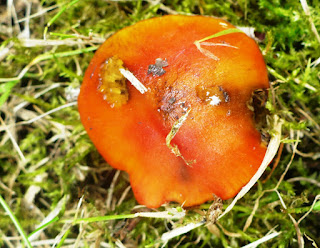This blog may help people explore some of the 'hidden' issues involved in certain media treatments of environmental and scientific issues. Using personal digital images, it's also intended to emphasise seasonal (and other) changes in natural history of the Swansea (South Wales) area. The material should help participants in field-based modules and people generally interested in the natural world. The views are wholly those of the author.
Tuesday, 31 July 2012
Saturday, 28 July 2012
Tuesday, 24 July 2012
Monday, 23 July 2012
Seeing the Changes 517
Again in Oxwich, saw Bloody cranesbill (Geranium sanguineum), Wild sage (Salvia nemerosa), Slender St John's wort (Hypericum pulchrum) and Lady's bedstraw (Galium verum) in bloom. Lots of Jellyfish were washed up and a primitive Grey chiton (Lepidochitona cinerea) was spotted. On land, a day-flying Silver 'Y' moth (Autographa gamma) and a male Common lizard (Zootoca vivipara) were spotted.
Sunday, 22 July 2012
Seeing the Changes 516
At Oxwich on the Gower, Orpine (Sedum telephinum), Eyebright (Euphrasia officinalis), Small-flowered cranesbill (Geranium pusillum) and Wild thyme (Thymus polytrichus) were all in flower. There were also Small skipper (Thymelicus flavus) and Small heath (Coenonympha pamphilus) butterflies, green bugs and mating Rhagonycha fulva beetles.
Saturday, 21 July 2012
Friday, 20 July 2012
Thursday, 19 July 2012
Insect Armageddon?
The displacement of the jet-stream with the consequent loss of the British summer with heavy rains and strong winds has been reported to have lasting and extensive detrimental effects on butterfly (http://www.guardian.co.uk/environment/2012/jul/12/david-attenborough-butterfly-count) and bee populations (although declines in the latter have also been linked to parasites and pesticides). All this is bad news for crops requiring insect pollination. Although why Attenborough has to illustrate his plea by being pictured with exotic butterflies in a Butterfly House is beyond me!
Wednesday, 18 July 2012
Sunday, 15 July 2012
Can't Get South Enough
Currently on holiday in mid France (La Tranche sur Mer) but the jet stream has followed us South. Plenty of strong winds and unseasonably heavy rain. What do the climate change deniers make of that? I have, however, seen a washed up Portuguese man o' war (Physalia physalia) and spotted my first ever Hoopoe bird (Upupa epeps) but I was unable to photograph it. Asked by email for my comments on an Australian surfer being bitten in two by a Great white shark and whether these sharks should consequently forfeit their conserved status. I think that a) sharks have been much more damaged (shark's fin soup) by humans than vice versa, b) the shark is only doing what it is designed to do to survive in its habitat, c) removal of all animals have could conceivably damage humans would be wholly inappropriate (noting that horses kill more people than do sharks), d) removal of a top predator could greatly disrupt the ecology of the southern ocean and e) politicians are not good at long-term issues.
Friday, 6 July 2012
A Giant Step Backwards!
Disturbing news that the signage of the National Trust at the Giant's Causeway in Northern Ireland includes an 'alternative' creationist account of its origins (http://www.guardian.co.uk/commentisfree/2012/jul/06/creationism-giants-causeway-national-trust). Although it is suggested that this is merElsy a cunning way of attracting the 'crank pound' , this is a distinctly dodgy thing to do. The causeway's geological origins are hardly much in doubt and its presence has no relevance to arguments about the validity of the theory of evolution.
Thursday, 5 July 2012
Seeing the Changes 511
Spotted a wax cap fungus (Hygrocybe sp) and a Common figwort (Scropularia nodosa) in Penclacwydd. In Bynea, Hairy St John's wort (Hypericum hirsutum) and Teasel (Dipsacus fullonum) were in flower. Vervain (Verbena officinalis) and Nipplewort (Lapsana communis) were blooming in Loughor whilst a Silver 'Y' moth (Autographa gamma) vibrated its wings.
Subscribe to:
Comments (Atom)
-
I n the UK and US, a pparently popular and successful vegan/vegetarian restaurants are reportedly closing or adding meat to their menus ( ...
-
Early ripening fruit may seem convenient but some folk think it confirms environmental stress. There's also a possibility th...


+lateral+Caswell.JPG)
+top+view+close+up+Bynea.jpg)
+basking+on+Bramble+Loughor.JPG)


























+NWCW.jpg)



















%20mating%20NWCW.jpg)

